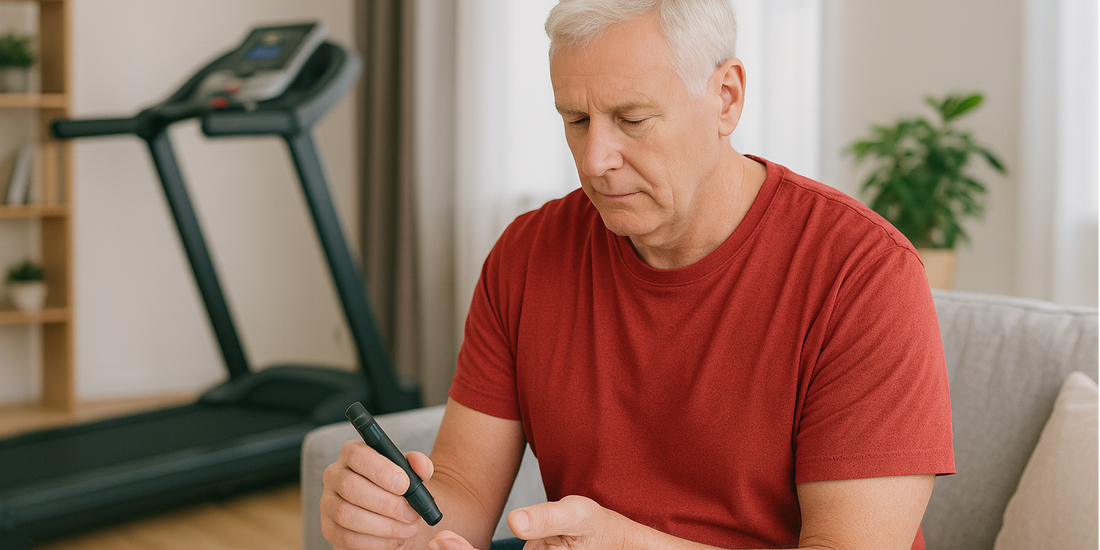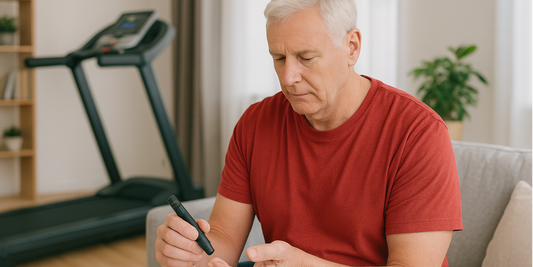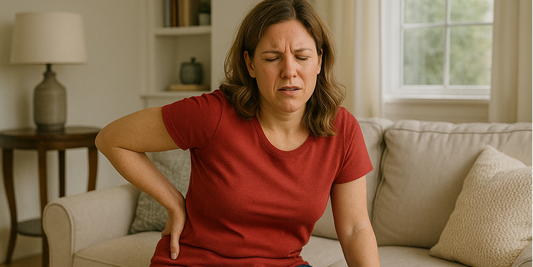
Exercise After Meals: How Light Treadmill Walking Can Help with Glucose Control
Share
Managing high blood sugar doesn’t have to mean strict diets or intense workouts, especially if you’re a senior or recovering from surgery. Sometimes the most effective change is also the simplest: taking a light walk after meals. In this blog, we explore how gentle treadmill walking for high blood sugar can support healthier glucose levels, improve energy, and offer a safe routine for those with limited mobility.
Why Blood Sugar Spikes After Meals

1 - What Happens When You Eat
After a meal, especially one high in carbohydrates, your body begins to break down food into glucose. This glucose enters the bloodstream and serves as fuel for your body’s cells. To help absorb this sugar, your pancreas releases insulin.
2 - The Role of Carbs and Insulin
While this is a natural process, many people (especially those with type 2 diabetes or prediabetes) don’t produce enough insulin or don’t respond to it efficiently. As a result, sugar stays in the bloodstream for too long, leading to what's commonly known as a “blood sugar spike.” Foods like white bread, rice, sugary drinks, and desserts can cause especially sharp increases.
3 - Why Spikes Matter for Seniors
For older adults, repeated post-meal spikes can be dangerous. High glucose levels over time can damage nerves, blood vessels, and vital organs. They also increase the risk of heart disease, fatigue, and mental fog. Additionally, seniors often experience decreased muscle mass and activity levels, which makes it harder for the body to naturally bring sugar levels back down.
The Science Behind Light Walking After Meals

1 - How Muscles Help Lower Glucose
When you move your body, even lightly, your muscles use glucose for energy. This process helps draw sugar out of the bloodstream without needing extra insulin. A short walk can improve insulin sensitivity and help your body regulate sugar levels more efficiently.
Research has shown that walking for just 10 to 30 minutes after a meal can significantly reduce post-meal glucose spikes. In fact, a light walk may be even more effective than taking a walk at other times of the day.
2 - Walking vs. Other Exercises
While cycling, strength training, and aerobic workouts are all beneficial, they may not be ideal for everyone. Seniors, people with joint pain, or those in post-operative recovery may find traditional exercise overwhelming. Light walking, especially on a treadmill, offers a low-impact and sustainable alternative. It’s an excellent form of post-meal exercise for blood sugar, as it’s gentle, predictable, and easy to maintain.
Why Treadmills Are a Safe and Convenient Option

1 - Walk Anytime, Rain or Shine
Let’s face it, weather, busy roads, and uneven sidewalks can make outdoor walking difficult or unsafe, especially for older adults. A treadmill provides a safe, reliable environment to walk after every meal, regardless of outside conditions.
2 - Gentle on Joints and Muscles
Modern treadmills offer padded surfaces that reduce stress on joints compared to concrete or asphalt. For seniors dealing with arthritis or osteoporosis, this makes a major difference in comfort and long-term joint health.
3 - Designed for Stability and Safety
Treadmills designed for seniors or recovery patients often include extended handrails, wide belts, low step-up heights, and emergency stop buttons. These features add confidence and reduce the risk of falling, allowing users to focus on the movement rather than the fear.
Practical Tips for Post-Meal Treadmill Use

1 - When to Walk and for How Long
Start walking around 15 to 30 minutes after your meal, when your blood sugar typically begins to rise. Begin with a 10- to 15-minute session, and increase to 20–30 minutes over time, depending on your comfort level and energy.
2 - Start Slow, Stay Consistent
Set your treadmill to a comfortable pace. Generally, 2.0 to 3.0 mph is ideal for beginners or seniors. Remember, it’s not about speed or distance; it’s about creating a gentle habit that you can maintain every day.
3 - Safety First: What to Keep in Mind
- Always wear proper walking shoes
- Hold onto handrails, especially in the beginning
- Keep water nearby to stay hydrated
- Use the safety clip or emergency stop cord if available
- Stop immediately if you feel dizzy, lightheaded, or overly tired
If you have a chronic health condition or are recovering from surgery, talk to your doctor before starting any new activity.
Conclusion
A short walk after meals can make a big difference, especially when it comes to managing high blood sugar. For seniors and recovery patients, it’s one of the easiest, safest ways to support better health naturally.
With the Redliro treadmill featuring extended handrails, you can walk confidently at home anytime, in any weather. Designed for comfort, safety, and stability, it is the perfect choice for gentle post-meal movement.



